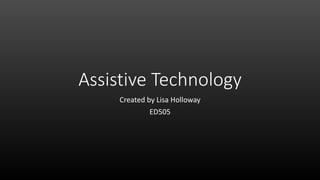
Assistive technology powerpoint
- 1. Assistive Technology Created by Lisa Holloway ED505
- 3. What types of learning problems does assistive technology address? AT can address many types of learning difficulties. A student who has difficulty writing can compose a school report by dictating it and having it converted to text by special software. A child who struggles with math can use a hand-held calculator to keep score while playing a game with a friend. And a teenager with dyslexia may benefit from AT that will read aloud his employer's online training manual. There are AT tools to help students who struggle with: • Hearing impairments • Seeing impairments • Learning disabilities • Physical disabilities As you can imagine, there is a large amount of AT to choose from. Let’s take a peek at just a few products available.
- 4. Hearing impaired AT FM Systems Hearing Assistive Technology: FM Systems | Infrared Systems | Induction Loop Systems | One-to-One Communicators | Other Hearing Assistive Technology Systems Solutions Personal frequency modulation (FM) systems are like miniature radio stations operating on special frequencies. The personal FM system consists of a transmitter microphone used by the speaker (such as the teacher in the classroom, or the speaker at a lecture) and a receiver used by you, the listener. The receiver transmits the sound to your ears or, if you wear a hearing aid, directly to the hearing aid. Personal FM systems are useful in a variety of situations, such as in a classroom lecture, in a restaurant, in a sales meeting, or in a nursing home or senior center. FM systems are also used in theaters, places of worship, museums, public meeting places, corporate conference rooms, convention centers, and other large areas for gathering. In these situations, the microphone/transmitter is built into the overall sound system. You are provided with an FM receiver that can connect to your hearing aid or cochlear implant. The receiver can also connect to a headset if you don’t wear a hearing aid
- 5. Seeing impaired AT The DAISY Consortium develops and promotes standards that make digital audiobooks accessible to persons with print disabilities. DAISY Consortium Question: DAISY Books Are Free, Downloadable Digital Audio Books DAISY, which stands for Digital Accessible Information System, is a set of standards developed to make written materials such as books more accessible to persons with print disabilities. A DAISY book is basically a set of electronic files that include audio narration, text marked with special navigation tags, and other files that synchronize the text with the audio. Who Are DAISY Books Designed For? The DAISY format was developed for persons who have limitations that make it difficult or impossible to read standard print. This group generally includes persons who are blind or visually impaired, persons with cognitive dysfunctions such as dyslexia, and persons with limited motor skills who might not be able to hold a book or turn pages.
- 6. Assistive technology service • Training and Technical Assistance for professionals • Training and Technical Assistance for families • Evaluation • Coordinating AT with other providers’ services
- 7. Learning disabled AT Electronic math work sheets Electronic math worksheets are software programs that can help a user organize, align, and work through math problems on a computer screen. Numbers that appear onscreen can also be read aloud via a speech synthesizer. This may be helpful to people who have trouble aligning math problems with pencil and paper. Freeform database software Used in conjunction with word processing or other software, this tool allows the user to create and store electronic notes by "jotting down" relevant information of any length and on any subject. He can later retrieve the information by typing any fragment of the original note. Graphic organizers and outlining Graphic organizers and outlining programs help users who have trouble organizing and outlining information as they begin a writing project. This type of program lets a user "dump" information in an unstructured manner and later helps him organize the information into appropriate categories and order.
- 8. Physically disabled AT Advanced assistive communication technology from Control Bionics If you are paralyzed, suffer from loss of speech, and loss of motor control, the Neuro Switch provides the easiest, most effective way to communicate and control your environment. The Neuro Switch is made for people with conditions such as acute spinal cord injury (SCI), ALS (Lou Gehrig’s Disease), MND (motor neuron disease), or cerebral palsy. The Neuro Switch’s small sensors sit on the surface of your skin, located on the muscle chosen to be your switch. You tense that muscle. The Neuro Switch detects your EMG signal, even if you can’t see or feel your muscle move. The Neuro Switch amplifies and interprets your signal, then sends it to a MacBook Air laptop, included with the device. On your MacBook, your signal reaches Assistive Ware‘s virtual keyboard and mouse controls. You get word prediction, text-to-speech capability, and full control over your computer.
- 9. Assistive Technology can help students with disabilities meet their IEP goals and enhance their academic experiences in the general education classroom. Although IDEA requires IEP teams to consider AT devices, there is currently no federal designated process for them to follow. What can we do? It is the responsibility of the administrators, teachers, parents, and IEP teams to add Assistive Technology to IEP’s to ensure each student with a disability has every tool needed to ensure educational success. For more information on Assistive Technology visit http://iris.peadbody.Vanderbilt.edu/at/chalcycle.htm
- 10. References Assistive Technology for kids with Learning Disabilities: an Overview. (2014). Retrieved from Reading Rocket: http://www.readingrockets.org/article/assistive- technology-kids-learning-disabilities-overview Assistive Technology for hearing impaired. (2014). Retrieved from http://www.asha.org/public/hearing/FM-Systems Leibs, A. (2009, May 5). Daisy Books Are Free, Downloadable Digital Audio Books. Retrieved from http://assistivetechnology.about.com/od/AudiobookPlayerOptions/f/What -Are-Daisy-Books.htm Ed.gov. (n .d.). Retrieved from Building the Legacy: IDEA 2004: http://idea.ed.gov/